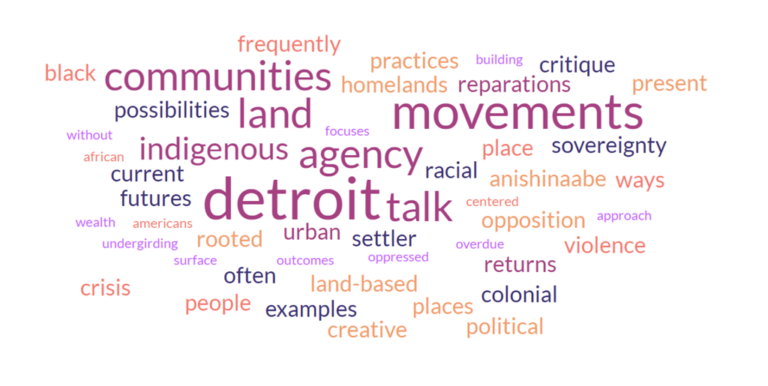Geography Outside-in

I am honored and delighted that you have given me the opportunity to act as your Association president for 2012-13. In these columns—a new experience for me—I seek to provoke us all to think critically and creatively about the relationship between Geography as a discipline and the multifaceted socionatural geographies that occupy and shape our planet. I approach these columns in the passionate belief that geography flourishes when its practitioners are willing to critically engage with one another. When we take others’ knowledge and beliefs as seriously as our own, consensus need not be our goal. As Helen Longino points out in her book The Fate of Knowledge, we can learn more through ongoing constructive disagreement, achieving excellence through diversity. Thus I invite you to respond to my columns throughout the year, in the spirit in which they are offered: esheppard [at] geog [dot] ucla [dot] edu.
We all simultaneously, paradoxically, occupy centers and margins. The Association of American Geographers occupies the institutional center of a discipline, plagued by its perceived marginalization in and beyond the academy. The academy is an acknowledged center of learning and knowledge production, but regarded with skepticism— marginalized—by the majority of those beyond its “Ivory Tower.” Ours is an Anglophone organization, whose discourses are shaped by powerfully positioned (too often, like myself, white and male) practitioners worried about how to improve livelihoods for the disadvantaged that they rarely encounter. Our Association’s members, without whom the AAG would cease to exist, wonder whether they have influence over its activities. What does it mean to approach such centers from their constituted margins, to turn Geography outside-in?
I begin with the Association. When I became Vice President a year ago, reflecting if nothing else my disciplinary name-recognition, I nevertheless felt like an outsider. As a member for almost forty years, attending most of the national meetings and reading the Newsletter fairly regularly, I came to realize that I had little idea about what goes on at AAG’s Meridian Place headquarters. Beyond organizing annual meetings (surprisingly, not a money-maker), I learned that the AAG has devoted enormous effort during the last decade to promoting the margins of the discipline: enhancing demographic diversity, improving graduate education, providing advice and support to fragile departments, reducing membership fees for those with low incomes (here and abroad), promoting geography in Latin America, Africa and Asia, and prioritizing human rights. The vast majority of us, I believe, would see these as important priorities, with the potential to help turn geography outside-in. No doubt, we each also would have opinions and criticisms of how the Association is going about these—as we would for such initiatives wherever we find them. Critical engagement between views would be informative for all concerned, but can only happen when information networks effectively connect margins into centers.
Fortunately, we live in an age where information can flow in less-hierarchical ways. Digital divides persist, and social networking has both progressive and regressive possibilities (whose geographical processes and implications remain ill-understood), but there remains significant potential. As Executive Director Doug Richardson highlights in his July-August column, the AAG is enhancing efforts to use information technologies inclusively (without disadvantaging those relying on paper). Members can subscribe to SmartBrief, and communicate through knowledge communities. National elections will now occur online, which can only enhance low participation rates. The AAG Newsletter will mutate into an online communications strategy, as will the Guide to Geography Programs, and book reviews will move from the journals to an online AAG Review of Books.
Yet these can only be the first steps— not yet realizing the georepresentational potential of Web 2.0. Without careful communications planning, there also is the danger of information overload. What else should be considered: A state-of-the-art AAG website? The Newsletter via Facebook? A presidential blog (or twitter)? A portal highlighting geographic research? A website publicizing timely geographic research to influence policy and opinion formation and attract attention to what we do? New open access publication venues? Less, not more? Share your ideas.
Turning Geography outside-in means turning our diversity (substantive, epistemological, political, socio-spatial) into a unifying strength. Enhancing geographic excellence through diversity requires attending to power-differences, however, to fully empowering the participation of marginalized positionalities in core conversations. As I stated when nominated, this must remain a high priority for the Association. In North America, building on Audrey Kobayashi’s important efforts, renewed anti-racism initiatives are vital, aimed particularly at including the expertise and voices of Native Americans, Blacks and Hispanics (recognizing how these intersect with other aspects of difference: class, gender, sexuality, location, etc.). Globally, it should entail incorporating the expertise of geographers and fellow-travelers living and working outside the well-resourced Anglophone halls of geographic influence. Everywhere, it should incorporate the experience of those whose lives we study. I will elaborate next month.
Eric Sheppard


